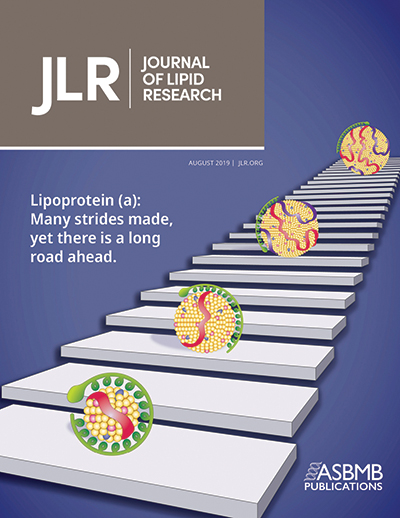JLR: Virtual issue sheds light on a key risk factor for heart disease
Because lipids such as cholesterol and triglycerides are hydrophobic and tend to clump up, rather than dissolve, in water, they need help getting around inside the body. Lipoproteins are complex assemblies with hydrophilic outer shells that package hydrophobic lipids in their core, allowing them to hitch a ride through the bloodstream. These delivery particles play an important role in the absorption of dietary lipids from the small intestine and also transport lipids to and from the liver.
 The cover of the JLR virtual issue depicts the Lp(a) particle following the steps of a walking path, getting bigger as the road stretches into infinity.
The cover of the JLR virtual issue depicts the Lp(a) particle following the steps of a walking path, getting bigger as the road stretches into infinity.
High levels of one particular class of lipoprotein, known as lipoprotein (a), are associated with atherosclerosis, inflammation and thrombosis, but no treatments are available in the clinic that specifically lower Lp(a), and much of what governs Lp(a) assembly is still unknown.
A new from the Journal of Lipid Research titled “Lipoprotein (a): Many strides made, yet there is a long road ahead” explores the past, present and future status of Lp(a) research and showcases researchers pushing this field forward. This issue was assembled by JLR Junior Associate Editor from Columbia University Irving Medical Center in New York City.
Several papers collected in this issue offer insights into how various Lp(a)-reducing drugs work. In one of these studies, and colleagues at the University of California, Davis, and the University of Hong Kong demonstrated that alirocumab — an inhibitor of the lipid-binding enzyme PCSK9 — could lower Lp(a) levels regardless of the isoform of proteins in Lp(a).
A study by and an international team of researchers suggests that another PCSK9 inhibitor, evolocumab, reduces Lp(a) levels partly by increasing the expression of LDL receptors.
Elisa Waldmann and at Ludwig Maximilian University of Munich wrote a review that discusses apheresis as an effective method of selectively clearing Lp(a) from the blood and reducing risk of cardiovascular disease.
Another review, penned by at McGill University, describes the association of Lp(a) with aortic valve disease and outlines steps toward developing much-needed preventive and therapeutic strategies.
Enjoy reading 91—«…´¥´√Ω Today?
Become a member to receive the print edition four times a year and the digital edition monthly.
Learn moreGet the latest from 91—«…´¥´√Ω Today
Enter your email address, and we’ll send you a weekly email with recent articles, interviews and more.
Latest in Science
Science highlights or most popular articles

Bacterial enzyme catalyzes body odor compound formation
Researchers identify a skin-resident Staphylococcus hominis dipeptidase involved in creating sulfur-containing secretions. Read more about this recent Journal of Biological Chemistry paper.

Neurobiology of stress and substance use
MOSAIC scholar and proud Latino, Bryan Cruz of Scripps Research Institute studies the neurochemical origins of PTSD-related alcohol use using a multidisciplinary approach.

Pesticide disrupts neuronal potentiation
New research reveals how deltamethrin may disrupt brain development by altering the protein cargo of brain-derived extracellular vesicles. Read more about this recent Molecular & Cellular Proteomics article.

A look into the rice glycoproteome
Researchers mapped posttranslational modifications in Oryza sativa, revealing hundreds of alterations tied to key plant processes. Read more about this recent Molecular & Cellular Proteomics paper.

Proteomic variation in heart tissues
By tracking protein changes in stem cell–derived heart cells, researchers from Cedars-Sinai uncovered surprising diversity — including a potential new cell type — that could reshape how we study and treat heart disease.

Parsing plant pigment pathways
Erich Grotewold of Michigan State University, an 91—«…´¥´√Ω Breakthroughs speaker, discusses his work on the genetic regulation of flavonoid biosynthesis.

